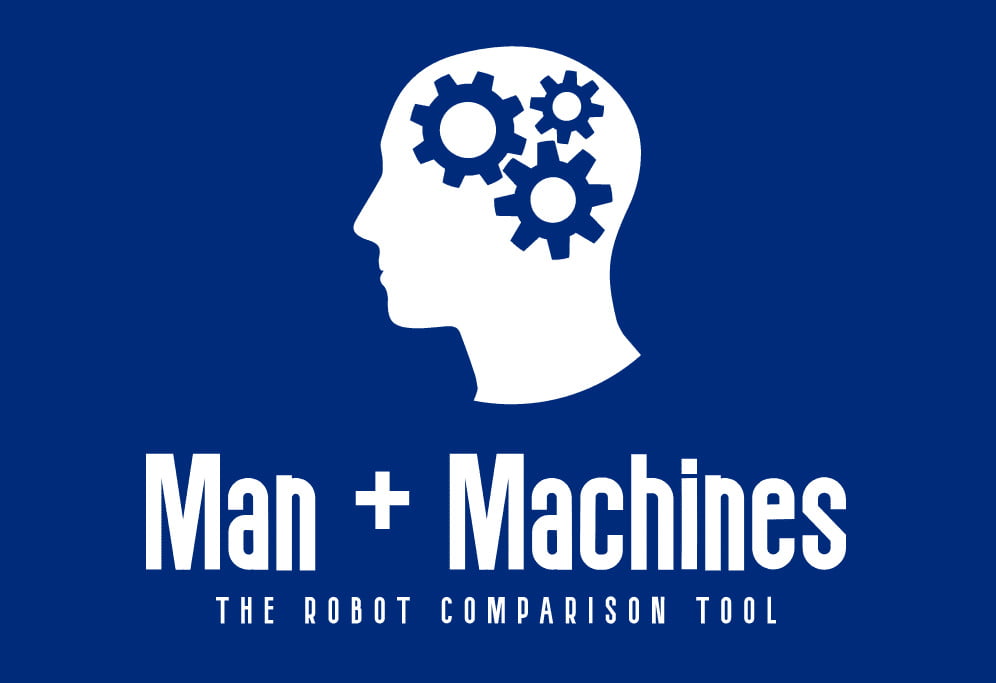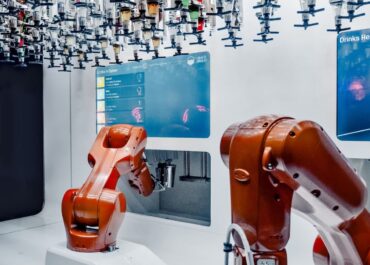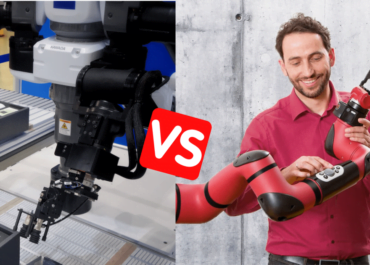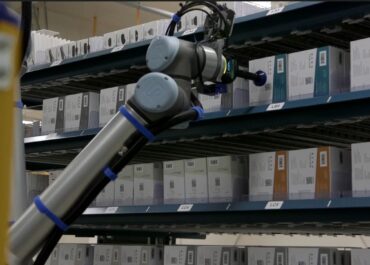Welding is one of the most complex and dangerous industrial applications. Welders must know how to fuse parts properly while avoiding the risks of burns and splashes.
So no wonder that automation solutions have quickly become a must-have for welding manufacturers. Collaborative robots have especially stood out on this task with their compact design and high flexibility.
But which cobot to choose and with which welding tool? And how do you integrate them into your existing application and workforce?
Here we give you our complete guide to getting started in the collaborative automation of your welding process.
Why use cobots for welding?
Of all the industrial tasks, welding is certainly one of the most dangerous. A worker who welds parts exposes himself to risks such as burns, splashes, cuts, and electrocution.
For this reason, historical robot manufacturers such as Fanuc or Yaskawa started early on to create robots specialized in welding. Their models have since proven to be successful in partially or fully automating these processes in large industries.
However, these industrial welding robots are not without flaws. They often cannot handle small parts, are difficult to move or repair, and require a large volume of welding to be profitable.
Collaborative robots overcome these limitations with their lightweight design, flexibility, and intelligence. Workers can quickly teach cobots specific welding applications, have them work on more detailed parts, and redeploy them to other workshops.
While these cobots don’t necessarily outperform standard robots on high volumes, they demonstrate high accuracy and quality of work. With cobots, manufacturers can reduce their production costs and allow their professional welders to focus on higher-value parts.
For all these reasons, a welding cobot might interest you if :
- You’re struggling to hire experienced welders.
- You want to optimize the cost and quality of your high mix, low volume welding process.
- You want to reduce your welders’ risk on the shop floor or help them focus on high-value parts.
Does this fit your needs? Then follow the guide!
Welding Cobot: a top 4
Whether they come from historic industrial manufacturers or newcomers, specialized cobot models provide a wide range of technical specifications and features. Here are the 4 best cobot series for welding applications:
Motoman HC10XP

A historical champion of industrial electric robotics, Yaskawa is one of the pioneers in arc welding robot design. With their Motoman series, they have redefined large-scale welding processes in specialized industries.
When they launched their Motoman HC models in 2015, they wanted to bring their expertise in arc welding to collaborative robots. Thus, the Motoman HC10XP is specifically designed to maximize welding work and make it safer.
They are popular among manufacturers for several reasons:
- Reach, speed and accuracy that meet the requirements for long or heavy welding parts.
- Fast set-up and deployment on new welding cells.
- A programming interface that allow users to teach welding movements without code knowledge.
- Safety features (collaborative space) that enable welders to monitor and intervene while not affecting robot productivity.
Universal Robot UR

The UR models are well known in the collaborative robot market. When it comes to managing welding applications, URs also show remarkable performance by supporting many external tools (under the UR+ open environment). Supplied as a kit with tools such as Vectis Automation or BotX, they provide many benefits on welding applications:
- A compact and light design to easily carry your robot from one welding station to another.
- Intuitive and quick set-up and programming accessible to any worker
- Maximum safety with advanced force sensors that prevent collisions
- Outstanding productivity and repeatability
Fanuc CRX

The iconic group of automation solutions Fanuc also has a long experience in welding robots. With their CR series of collaborative robots, they especially wanted to make automation kits accessible to any small to medium-sized industry. Their most recent models, the CRX, offer even one of the best experiences in welding applications.
Thanks to key selling points:
- Strong build and technical features that allow them to handle heavy and large tools and welding parts.
- A programming software dedicated to welding. With it, users can code tasks in record time and optimize the process continuously. Combined with a mobility solution, they can also redeploy them very quickly.
- They support a wide range of welding tools (laser, plasma, TIG or arc). They can also be equipped with additional sensory sensors (force, touch, vision) to improve their accuracy.
Omron TM

Omron Industrial Group teamed up with manufacturer Techman in 2018 to resell state-of-the-art cobot models. As a result, Omron TM robots feature excellent force sensors and smart vision, among other features.
Recently, they teamed up with AWL to provide a dedicated welding cell, QUBE. This solution aims to facilitate welding operations in medium industries, with strong arguments:
- An enclosed cell that maximizes space and ensures optimal safety.
- A highly accurate robot that can handle high quality parts.
- With an easy to program interface, robot and certified welders can collaborate, to work twice as fast.
Which cobotic welding kit to choose?
There are many manufacturers of welding equipment on the market. Some have had the idea of offering kits that include all the tools for cobots to weld. Here are the most famous ones:
Fab-Pak – Lincoln Electric

Lincoln Electric is the historical leader in industrial welding, specializing in electric arc applications. They have designed some of the most efficient torches and torch feeders on the market.
With their Fab-Pak line, they have brought their expertise to collaborative applications. The cobotic welding kits include a mobile carriage, a sensitive Fanuc CR cobot and a certified power base. With this kit, you can automate your task without the need for code and redeploy the welding cell in an instant.
RobiPak – Abicor-Binzel

Abicor-Binzel is an international expert in industrial welding. With their know-how, their welding torches are recognized among the best in the market. To make this application accessible to small and medium industries, they recently introduced their RobiPak kits which contain torches and assembly cables of high manufacturing quality. With them, you are sure to do a good job!
Wandelbot

An innovative automation company, Wandelbot offers software that significantly improves industrial applications without code. With their welding kit, you’ll have a compact, accurate torch and an interface attached to the UR cobot that optimizes your welding path in no time. Just point and an AI-based algorithm will automatically program a efficient work process.
Vectis Automation

Vectis Automation is a welding company specialized in collaborative applications. Combined with the latest UR10e robots, it offers one of the most successful welding robotics kits on the market. It provides both a travel carriage, a welding torch specific to cobots, and a powerful power base.
Bot-X – Red-D-Arc

Red-D-Arc is a welding solution provider standing out with innovative service. Instead of buying a welding device, you can simply rent it when you need it and return it when you don’t need it anymore. This way, you can leverage the high-quality equipment from this experienced manufacturer whenever you are short on manpower. The kit includes everything you need to get started quickly: a UX robot, an ergonomic interface, and an advanced welding device.
How to choose and integrate cobots into your welding cell?
Automating your welding process involves a meticulous process of selecting and integrating the right solution. Here’s how to do it step by step. You can also read our article dedicated to this topic.
1. Define the need
Agree on the goals of your automation project. Do you need a cobot to make up for a lack of manpower, to optimize the performance and costs of your processes, or to assist and protect your professional welders?
2. Choose the right device
Based on those goals, you can then define the criteria for choosing the right model of cobot or welding kit. You may favor for example robots that can be easily installed without technical knowledge, flexible solutions for your on-demand production, safe welding equipment or good workmanship.
3. Adapting the welding cell
Once you have purchased the right welding robot solution, you can then think about integrating it into your existing welding cell. This involves reconfiguring the application space. You can use a closed shop or take the opportunity to open it up a bit and allow the welders to move around.
4. Rethink the work organization
The organization of your workforce and their contribution must also be rethought. What will be the new role of welders in your collaborative application? Supervisors who monitor and adapt the welding robots? Or independent agents who can now focus on welding higher quality parts?
5. Conduct a risk assessment
As an essential step before deployment, you must perform a risk assessment of your new application. You need to define the potential hazards and how to prevent them, whether they are related to the robot, the welding torch or the equipment.
6. Conduct employee training
Finally, you need to organize the training of your employees to these new tools. Even though these collaborative robots are easier to use than other devices, they still require knowledge of how they work. Particular emphasis should be put on security protocols and functionality. This will help build trust with employees.
Now it’s your turn to find the ideal welding cobot and integrate it into your processes. We promise you, with this method, you will get all the benefits possible!
And if you want a more in-depth comparison of cobotic models, you can check out our guide.




